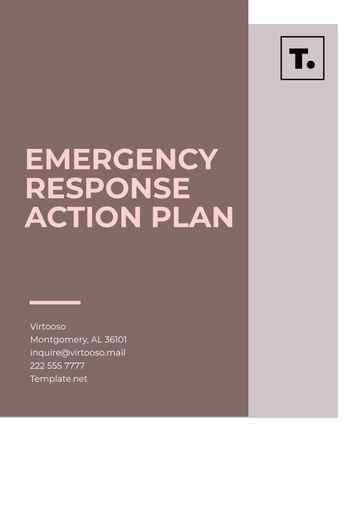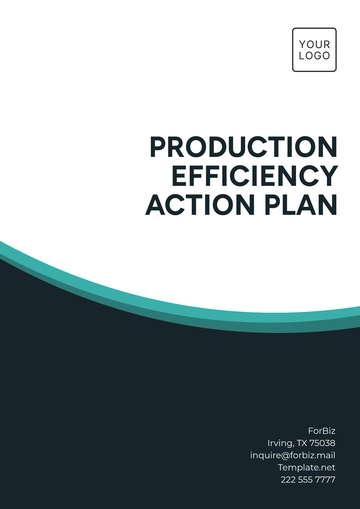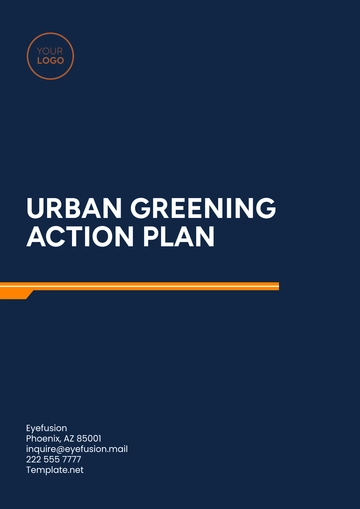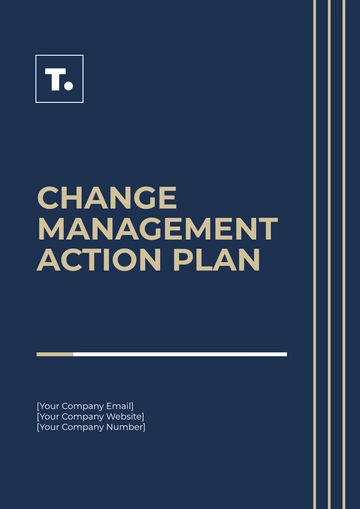Free Agriculture Action Plan

I. Executive Summary
A. Overview of the Action Plan
[Your Company Name]'s Agriculture Action Plan aims to revolutionize farming practices in our region by promoting sustainable agriculture, integrating advanced technologies, and enhancing market access for farmers. It represents a collaborative effort among government agencies, NGOs, and local communities to address pressing challenges and capitalize on emerging opportunities in the agricultural sector.
B. Key Objectives
The primary objective is to increase agricultural productivity and resilience through the adoption of sustainable farming techniques and innovative technologies.
Another key objective is to improve farmers' income and livelihoods by enhancing market opportunities and value chain efficiencies.
Additionally, the plan seeks to promote environmental stewardship by reducing agricultural inputs and mitigating environmental impacts.
C. Summary of Strategies and Actions
The strategies include promoting soil health through organic farming practices, implementing precision agriculture technologies, and strengthening market linkages for smallholder farmers. These actions are designed to foster a sustainable agricultural ecosystem that supports economic growth while conserving natural resources.
D. Expected Outcomes and Benefits
Anticipated outcomes include a [00]% increase in crop yields, leading to improved food security and higher farm incomes.
Benefits also extend to environmental gains such as reduced water usage and enhanced biodiversity through sustainable land management practices.
Furthermore, the plan aims to foster social benefits by empowering rural communities with new skills and opportunities for economic advancement.
II. Introduction
A. Background of the Agricultural Sector
Agriculture has been a cornerstone of our region's economy, providing livelihoods to [00]% of the population and contributing significantly to GDP. Traditional farming methods have sustained production but are increasingly challenged by environmental pressures and changing market demands.
B. Importance of Agricultural Development
Agricultural development is crucial not only for ensuring food security but also for promoting economic growth and rural development. By modernizing farming practices and integrating technological innovations, we can enhance productivity and profitability while safeguarding natural resources for future generations.
C. Purpose and Scope of the Action Plan
This Action Plan aims to address key challenges faced by farmers, including soil degradation, water scarcity, and market access limitations. It outlines a strategic roadmap for achieving sustainable agricultural growth over the next five years through targeted interventions and collaborative efforts with stakeholders.
III. Situation Analysis
A. Current State of Agriculture
Agricultural Production
Our region primarily produces staple crops such as maize, wheat, and rice, with average yields varying due to climatic factors and soil quality. Recent years have seen fluctuations in production levels, highlighting the need for more resilient farming practices.
Farming Practices and Technologies
Traditional farming methods predominate, relying heavily on chemical inputs and conventional irrigation systems. Limited adoption of modern technologies like precision farming and biotechnology has constrained productivity gains and resource efficiency.
Market Trends and Demand
There is a growing consumer preference for organic and sustainably produced agricultural products. Farmers face challenges in meeting quality standards and accessing lucrative markets, especially for value-added products.
B. Challenges and Issues
Environmental Factors
Soil erosion, depletion of groundwater resources, and climate variability pose significant risks to agricultural sustainability. Sustainable land management practices are needed to mitigate these environmental pressures.
Economic Constraints
High input costs, fluctuating commodity prices, and inadequate access to credit and markets hinder profitability and investment in agricultural enterprises. Strengthening market linkages and improving price transparency are critical for enhancing farm incomes.
Social and Policy Challenges
Limited access to agricultural extension services and technical support impedes farmer adoption of new technologies and practices. Policy inconsistencies and regulatory barriers further complicate efforts to modernize the agricultural sector.
IV. Goals and Objectives
A. Long-Term Goals
The overarching goal is to transform our agricultural sector into a model of sustainability and resilience by 2050.
Enhance food security by increasing agricultural productivity and diversifying crop production.
Improve farmers' livelihoods and rural incomes through enhanced market access and value chain integration.
B. Short-Term Objectives
Specific Objectives
Introduce sustainable farming practices on 100 demonstration farms within the first year.
Increase adoption of climate-resilient crop varieties by [00]% over the next two years.
Measurable Targets
Achieve a [00]% reduction in water usage per hectare through improved irrigation techniques by Year 3.
Increase average farm incomes by [00]% through value-added processing and direct market sales by Year 5.
Timelines for Achievement
Year 1: Pilot sustainable agriculture initiatives and assess feasibility across diverse agro-ecological zones.
Year 2-3: Scale up successful practices and technologies to 500 additional farms, focusing on high-impact regions.
V. Strategies and Actions
A. Sustainable Agriculture Practices
Soil Management
Implement soil conservation practices such as cover cropping and contour farming to reduce erosion and improve soil structure. Conduct regular soil testing and nutrient management workshops to optimize fertilizer use and enhance soil fertility. Encourage farmers to adopt organic farming techniques, composting methods, and biofertilizers to minimize reliance on synthetic chemicals.
Water Conservation
Promote the use of efficient irrigation systems such as drip irrigation and micro-sprinklers to reduce water wastage and improve crop water-use efficiency. Implement rainwater harvesting techniques and construct water storage facilities to mitigate the impact of seasonal water shortages. Provide training and subsidies for farmers to adopt water-saving technologies and practices tailored to local agro-climatic conditions.
Crop Diversification
Introduce climate-resilient crop varieties and promote crop diversification strategies to enhance resilience against climate change impacts. Facilitate farmer field schools and demonstration plots to showcase the benefits of crop rotation, intercropping, and agroforestry systems. Strengthen market linkages for specialty crops and high-value commodities to diversify income sources and reduce market risks for farmers.
B. Technology and Innovation
Adoption of Precision Farming
Establish a precision agriculture demonstration farm equipped with GPS-guided tractors, drones, and soil sensors to showcase precision farming technologies. Train farmers in the use of data-driven decision-making tools for precision nutrient management and pest control. Collaborate with agribusinesses and research institutions to develop customized precision farming solutions that are scalable and affordable for smallholder farmers.
Use of Agricultural IoT
Pilot IoT devices and sensor technologies for real-time monitoring of soil moisture levels, weather conditions, and crop health parameters. Develop a digital platform to collect and analyze data from IoT sensors to provide actionable insights to farmers. Provide technical support and training to farmers on the installation, maintenance, and interpretation of IoT data for improved farm management practices.
Integration of Renewable Energy
Promote the adoption of renewable energy solutions such as solar-powered irrigation pumps and biogas digesters on farms. Facilitate access to financing options and subsidies for renewable energy installations to reduce upfront costs for farmers. Collaborate with energy providers and government agencies to develop policies and incentives that support the widespread adoption of clean energy technologies in agriculture.
C. Market Access and Value Chain Enhancement
Market Research and Analysis
Conduct market surveys and feasibility studies to identify emerging market trends and consumer preferences for agricultural products. Develop market intelligence reports to guide farmers in making informed decisions on crop selection and production planning. Establish farmer cooperatives and producer groups to aggregate produce, negotiate better prices, and access premium markets for organic and certified products.
Improvement of Infrastructure
Upgrade rural roads, storage facilities, and market infrastructure to reduce post-harvest losses and improve market access for farmers. Construct cold storage units and processing facilities near agricultural production hubs to extend the shelf life of perishable crops and add value through processing. Strengthen logistics and transportation networks to ensure timely delivery of farm produce to local and export markets.
Strengthening of Farmer Cooperatives
Provide capacity-building training in cooperative governance, financial management, and collective marketing strategies to farmer groups. Facilitate the formation of farmer-owned enterprises and cooperative business models to enhance bargaining power and negotiate fair prices for agricultural inputs and outputs. Foster partnerships with private sector stakeholders and retailers to create direct market linkages for smallholder farmers.
VI. Implementation Plan
A. Action Steps and Activities
Identification of Responsible Parties
Establish an Agriculture Action Committee comprising representatives from government agencies, NGOs, farmer associations, and private sector partners. Assign clear roles and responsibilities to each stakeholder for implementing specific actions and achieving targeted outcomes. Develop a project management framework with designated project leads and monitoring mechanisms to track progress and ensure accountability.
Allocation of Resources (Funding, Equipment)
Secure funding from government grants, international development agencies, and private sector investments to finance project activities. Allocate resources for the procurement of agricultural machinery, technology equipment, and infrastructure upgrades necessary for implementing the Action Plan. Establish a transparent budgeting process with periodic financial audits to manage expenditures and optimize resource allocation.
Timeline for Each Action
Develop a detailed timeline with phased milestones and deliverables for each action item outlined in the Action Plan. Prioritize early wins and quick-win initiatives to build momentum and demonstrate tangible results to stakeholders. Conduct regular progress reviews and adjustment sessions to adapt strategies based on evolving market dynamics, technological advancements, and stakeholder feedback.
B. Monitoring and Evaluation
Key Performance Indicators (KPIs)
Define specific KPIs related to agricultural productivity, environmental sustainability, farmer income levels, and market competitiveness. Measure progress against baseline data to assess the impact of interventions and identify areas for improvement. Establish benchmark targets for KPIs to track performance and ensure alignment with strategic goals and objectives.
Monitoring Mechanisms
Implement a robust monitoring and evaluation framework with regular data collection, analysis, and reporting mechanisms. Utilize digital platforms and data management systems to streamline data collection processes and enhance transparency. Conduct field visits, surveys, and stakeholder consultations to gather qualitative feedback and validate quantitative data on the ground.
Evaluation Criteria
Conduct periodic evaluations and impact assessments led by independent experts and stakeholders to evaluate the effectiveness and efficiency of project interventions. Review project outcomes against predefined success criteria and benchmarks to determine the overall success and impact of the Agriculture Action Plan. Incorporate lessons learned and best practices into future planning cycles to continuously improve program outcomes and sustainability.
VII. Stakeholder Engagement
A. Stakeholder Analysis
Identification of Stakeholders
Engage a diverse range of stakeholders including farmers, farmer cooperatives, agricultural extension services, research institutions, government agencies, NGOs, and private sector partners. Foster inclusive participation and collaboration among stakeholders to leverage expertise, resources, and networks for collective action and mutual benefit. Tailor engagement strategies to address the unique needs and priorities of different stakeholder groups.
Roles and Responsibilities
Clarify roles and responsibilities for each stakeholder group based on their expertise, resources, and spheres of influence within the agricultural sector. Establish partnerships and alliances with stakeholders committed to supporting sustainable agricultural development and achieving shared goals outlined in the Action Plan. Promote active participation and decision-making processes that empower stakeholders to contribute to the design, implementation, and monitoring of initiatives.
B. Collaboration and Partnerships
Cooperation with Government Agencies
Collaborate with relevant government ministries, departments, and agencies responsible for agriculture, rural development, and environmental management. Align project activities and policy advocacy efforts with national development plans, agricultural strategies, and regulatory frameworks to promote synergies and avoid duplication of efforts. Advocate for policy reforms and investments that prioritize sustainable agriculture, climate resilience, and inclusive rural development.
Engagement with NGOs and Community Organizations
Partner with local and international NGOs, community-based organizations, and civil society groups to mobilize resources, expertise, and grassroots networks for community-led initiatives. Strengthen institutional capacities and technical capabilities of NGOs to deliver extension services, training programs, and support services to farmers. Foster collaboration on research, knowledge sharing, and innovation to develop context-specific solutions and scalable models for sustainable agriculture.
VIII. Risk Management
A. Identification of Risks and Uncertainties
Environmental Risks
Assess risks related to climate change impacts, natural disasters, and environmental degradation affecting agricultural production systems. Implement climate-resilient farming practices and adaptive strategies to mitigate risks and build resilience against extreme weather events. Monitor soil health, water availability, and ecosystem services to minimize environmental vulnerabilities and sustainably manage natural resources.
Economic Risks
Identify risks associated with market volatility, price fluctuations, and financial constraints affecting farm profitability and income stability. Diversify income sources, explore niche markets, and establish market linkages to reduce dependence on traditional commodity markets. Strengthen financial management practices, access to credit, and insurance mechanisms to buffer farmers against economic shocks and financial uncertainties.
Social and Political Risks
Evaluate risks stemming from social unrest, policy changes, and regulatory uncertainties impacting agricultural operations and investment decisions. Engage in policy advocacy, dialogue with policymakers, and stakeholder consultations to address governance issues and create an enabling environment for sustainable agricultural development. Foster social cohesion, community empowerment, and inclusive governance processes to promote social equity and resilience in rural communities.
B. Mitigation Strategies
Risk Prevention Measures
Implement risk prevention measures such as diversification of crops, income sources, and market outlets to spread risks and enhance farm resilience. Adopt sustainable land management practices, water conservation techniques, and biodiversity conservation measures to mitigate environmental risks and preserve ecosystem services. Strengthen early warning systems, disaster preparedness plans, and community-based adaptation strategies to respond proactively to climate-related risks and natural hazards.
Contingency Plans
Develop contingency plans and emergency response protocols to mitigate the impact of unforeseen events such as crop failures, pest outbreaks, or market disruptions. Establish contingency funds, insurance schemes, and credit facilities to provide financial safety nets and support recovery efforts for affected farmers. Collaborate with humanitarian agencies, local authorities, and community organizations to ensure timely and effective response measures during crises and emergencies.
IX. Sustainability and Impact
A. Sustainable Development Goals (SDGs) Alignment
Align the Agriculture Action Plan with global and national Sustainable Development Goals (SDGs) related to poverty alleviation, food security, sustainable agriculture, and climate action. Track progress and report on contributions to SDG targets through measurable outcomes and indicators. Foster partnerships and collaborations that advance sustainable development principles, social inclusion, and environmental stewardship in agricultural practices and policies.
B. Environmental Impact Assessment
Conduct environmental impact assessments (EIAs) to evaluate the ecological footprint of agricultural activities and interventions outlined in the Action Plan. Monitor changes in soil health, water quality, biodiversity, and carbon sequestration rates to assess positive and negative environmental impacts. Implement mitigation measures and adaptive management strategies to enhance ecosystem resilience, conserve natural resources, and promote biodiversity conservation in agricultural landscapes.
C. Social and Economic Benefits
Measure social and economic benefits derived from the Agriculture Action Plan, including improvements in farmer livelihoods, income levels, and employment opportunities. Assess changes in rural poverty rates, gender equity, and social inclusion outcomes resulting from inclusive agricultural development initiatives. Document case studies, success stories, and testimonials from farmers to demonstrate the transformative impact of sustainable agriculture on local communities, livelihoods, and well-being.
X. Communication and Outreach
A. Public Awareness Campaigns
Information Dissemination
Launch public awareness campaigns using multimedia platforms, community radio, and social media channels to educate farmers and stakeholders about the benefits of sustainable agriculture practices. Develop educational materials, training modules, and knowledge-sharing platforms to promote best practices in soil conservation, water management, and climate-smart farming techniques. Organize field demonstrations, workshops, and agricultural fairs to showcase successful case studies and innovative solutions.
Capacity Building
Build capacities of extension agents, farmer trainers, and community leaders to effectively communicate and disseminate agricultural knowledge and technologies to rural communities. Provide technical training, coaching, and mentoring programs to empower farmers with skills in agroecology, organic farming, and integrated pest management. Foster peer-to-peer learning networks and knowledge exchange platforms to facilitate continuous learning and adoption of sustainable agricultural practices.
B. Stakeholder Engagement
Consultation and Feedback Mechanisms
Establish inclusive consultation mechanisms, feedback loops, and participatory decision-making processes to engage stakeholders in the design, implementation, and evaluation of agricultural development initiatives. Conduct stakeholder surveys, focus group discussions, and public consultations to gather input, address concerns, and build consensus on strategic priorities and action plans. Foster transparent communication channels and dialogue forums that promote trust, collaboration, and accountability among diverse stakeholder groups.
Partnerships and Alliances
Forge strategic partnerships and alliances with academia, research institutions, private sector enterprises, and international organizations to leverage expertise, resources, and innovative solutions for sustainable agricultural development. Collaborate on joint research projects, technology transfer initiatives, and knowledge-sharing platforms that accelerate the adoption of best practices and scalable innovations in agriculture. Strengthen networks, coalitions, and advocacy platforms to mobilize collective action and influence policy reforms that support inclusive rural development and agricultural transformation.
- 100% Customizable, free editor
- Access 1 Million+ Templates, photo’s & graphics
- Download or share as a template
- Click and replace photos, graphics, text, backgrounds
- Resize, crop, AI write & more
- Access advanced editor
Ensure your agricultural strategies flourish with the Agriculture Action Plan Template from Template.net. This editable and customizable template empowers you to tailor sustainable farming initiatives effortlessly. Utilize its intuitive AI Editor Tool to streamline planning, from precision farming techniques to market access strategies. Elevate your agricultural productivity and resilience with a template designed for success.





























